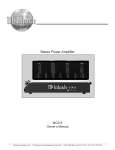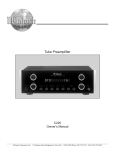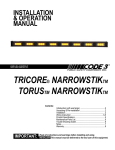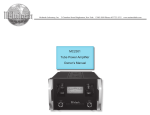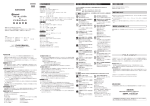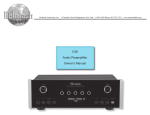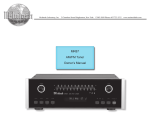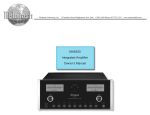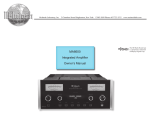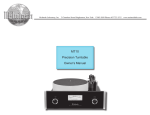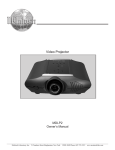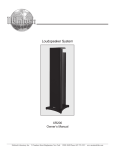Download McIntosh MPC1500 remote power controller
Transcript
McIntosh Laboratory, Inc. 2 Chambers Street Binghamton, New York MPC1500 Torus Power Technology under license from Plitron Manufacturing Inc. Power Controller Owner’s Manual 13903-2699 Phone: 607-723-3512 www.mcintoshlabs.com The lightning flash with arrowhead, within an equilateral triangle, is intended to alert the user to the presence of uninsulated “dangerous voltage” within the product’s enclosure that may be of sufficient magnitude to constitute a risk of electric shock to persons. WARNING - TO REDUCE RISK OF FIRE OR ELECTRICAL SHOCK, DO NOT EXPOSE THIS EQUIPMENT TO RAIN OR MOISTURE. IMPORTANT SAFETY INSTRUCTIONS! PLEASE READ THEM BEFORE OPERATING THIS EQUIPMENT. 1. Read these instructions. 2. Keep these instructions. 3. Heed all warnings. 4. Follow all instructions. 5. Do not use this apparatus near water. 6. Clean only with a dry cloth. 7. Do not block any ventilation openings. Install in accordance with the manufacturer’s instructions. 8. Do not install near any heat sources such as radiators, heat registers, stoves, or other apparatus (including amplifiers) that produce heat. 9. Do not defeat the safety purpose of the polarized or grounding-type plug. A polarized plug has two blades with one wider than the other. A grounding type plug has two blades and a 2 The exclamation point within an equilateral triangle is intended to alert the user to the presence of important operating and maintenance (servicing) instructions in the literature accompanying the appliance. NO USER-SERVICEABLE PARTS INSIDE. REFER SERVICING TO QUALIFIED PERSONNEL. third grounding prong. The wide blade or the third prong are provided for your safety. If the provided plug does not fit into your outlet, consult an electrician for replacement of the obsolete outlet. 10. Protect the power cord from being walked on or pinched particularly at plugs, convenience receptacles, and the point where they exit from the apparatus. 11. Only use attachments/accessories specified by the manufacturer. 12. Use only with the cart, stand, tripod, bracket, or table specified by the manufacturer, or sold with the apparatus. When a cart is used, use caution when moving the cart/ apparatus combination to avoid injury from tip-over. 13. Unplug this apparatus during lightning storms or when unused for long periods of time. 14. Refer all servicing to qualified service personnel. Servicing is required when the apparatus has been damaged in any way, such as power- To prevent the risk of electric shock, do not remove cover or back. No user-serviceable parts inside. supply cord or plug is damaged, liquid has been spilled or objects have fallen into the apparatus, the apparatus has been exposed to rain or moisture, does not operate normally, or has been dropped. 15. Do not expose this equipment to dripping or splashing and ensure that no objects filled with liquids, such as vases, are placed on the equipment. 16. To completely disconnect this equipment from the a.c. mains, disconnect the power supply cord plug from the a.c. receptacle. 17. The mains plug of the power supply cord shall remain readily operable. 18. Do not expose batteries to excessive heat such as sunshine, fire or the like. 19. Connect mains power supply cord only to a mains socket outlet with a protective earthing connection. Preamble and Table of Contents Model Versions Table of Contents McIntosh Products are marketed world wide. There are several versions of the MPC1500 to meet the different AC Power and Safety Requirements in each country. This Owner’s Manual covers the three versions of the MPC1500. In the Owner’s Manual there is a section containing common information for all three versions of the MPC1500 and separate sections pertaining to the specific version of the MPC1500. The designation of MPC1500-NA refers to the 120VAC version for use in North America. Refer to figure MPC1500-NA. The designation of MPC1500-EU refers to the 230VAC version for use in Continental Europe. Refer to figure MPC1500-EU. The designation of MPC1500-JA refers to the 100VAC version for use in Japan. Refer to figure MPC1500-JA. Safety Instructions...................................................... 2 Preamble and Table of Contents................................. 3 Thank You and Please Take a Moment....................... 4 Technical Assistance and Customer Service.............. 4 General Information................................................... 4 Connector and Cable Information.............................. 5 Introduction................................................................. 5 Performance Features................................................. 5 Dimensions................................................................. 6 Installation.................................................................. 7 OUTLETS Figure MPC1500-NA MCP1500-NA Rear Panel Connections.............................................. 8 How to Connect in a Two Channel System................ 9 How to Connect in a Multi Channel System.............10 Front Panel Displays and Controls.............................11 How to Operate the MPC1500..............................12-13 Specifications............................................................ 14 MCP1500-EU Figure MPC1500-EU Rear Panel Connections.............................................16 How to Connect in a Two Channel System...............17 How to Connect in a Multi Channel System.............18 Front Panel Displays and Controls.............................19 How to Operate the MPC1500............................. 20-21 Specifications............................................................ 22 MCP1500-JA Figure MPC1500-JA Copyright 2009 © by McIntosh Laboratory, Inc. Rear Panel Connections............................................ 24 How to Connect in a Two Channel System.............. 25 How to Connect in a Multi Channel System............ 26 Front Panel Displays and Controls.............................27 How to Operate the MPC1500............................. 28-29 Specifications............................................................ 30 Packing Instruction................................................... 31 3 Thank You Customer Service Your decision to own this McIntosh MPC1500 Power Controller ranks you at the very top among discriminating music listeners. You now have “The Best.” The McIntosh dedication to “Quality,” is assurance that you will receive many years of enjoyment from this component. Please take a short time to read the information in this manual. We want you to be as familiar as possible with all the features and functions of your new McIntosh. If it is determined that your McIntosh product is in need of repair, you can return it to your Dealer. You can also return it to the McIntosh Laboratory Service Department. For assistance on factory repair return procedure, contact the McIntosh Service Department at: Please Take A Moment The serial number, purchase date and McIntosh Dealer name are important to you for possible insurance claim or future service. The spaces below have been provided for you to record that information: Serial Number:________________________________ Purchase Date:_ _______________________________ Dealer Name:_ ________________________________ Technical Assistance If at any time you have questions about your McIntosh product, contact your McIntosh Dealer who is familiar with your McIntosh equipment and any other brands that may be part of your system. If you or your Dealer wish additional help concerning a suspected problem, you can receive technical assistance for all McIntosh products at: McIntosh Laboratory, Inc. 2 Chambers Street Binghamton, New York 13903 Phone: 607-723-1545 Fax: 607-724-0549 4 McIntosh Laboratory, Inc. 2 Chambers Street Binghamton, New York 13903 Phone: 607-723-3515 Fax: 607-723-1917 General Information 1. For additional connection information, refer to the owner’s manual(s) for any component(s) connected to the MPC1500 Power Controller. 2. The Main AC Power going to the MPC1500 and any other McIntosh Component(s) should not be applied until all the system components are connected together. Failure to do so could result in malfunctioning of some or all of the system’s normal operations. 3. In the event the MPC1500 Power Controller overheats due to improper ventilation and/or high ambient temperature, the Power Controller will switch off. When the MPC1500 has returned to a safe operating temperature, normal operation will resume. 4. The MPC1500 is designed for connection of Audio/ Video Components with low energy consumption. This would include components such as Preamplifiers, A/V Control Centers, Source Components, Integrated Amplifiers and Power Amplifiers with low to modest power output. General Information, con’t The total amount of current drawn by all the components connected to the MPC1500 should not exceed Amps rating indicated on the rear panel of your MPC1500. Typically, components consuming low amounts of energy are rated in watts. Refer to the chart below for converting a wattage rating into an approximate current rating. MPC1500 Versions Watts Rating on component 0- 50 Watts 51-100 Watts 101-150 Watts NA - (120VAC) EU - (230VAC) JA - (100VAC) Approximate current Approximate current Approximate current 0.5A 0.25A 0.6A 1A 0.5A 1.2A 1.5A 0.75A 1.8A 151-200 Watts 2A 1A 2.4A 201-250 Watts 2.5A 1.25A 3A 5. When discarding the unit, comply with local rules or regulations. Batteries should never be thrown away or incinerated but disposed of in accordance with the local regulations concerning battery disposal. 6. For additional information on the MPC1500 and other McIntosh Products please vist the McIntosh Web Site at www.mcintoshlabs.com. General Information, Cable Information, Introduction and Performance Features Connector and Cable Information Power Control Connectors The MPC1500 Global Power Control Input and Local Power Control Inputs receive On/Off signals from +5 to +12 volts. The Global Power Control Output will provide a +12 volt Output Signal with a current up to 20mA. The Local Power Control Outputs will in turn provide Power Control from +5 to +12 volt Output SigMeter nal (Input Signal Dependent). Illumination Control The Global Power Control Input Ground has an additional connection for controlling the illumination of the MPC1500 Voltage and Current Output Meters. The 1/8 inch stereo mini phone plug connects to a McIntosh Component Power Control Output. Note: The Power Control Connecting Cable is available from the McIntosh Parts Department: Data and Power Control Cable Part No. 170-202 Six foot, shielded 2 conductor, with 1/8 inch stereo mini phone plugs on each end. Introduction Now you can add to your system the advantage of traditional McIntosh standards of excellence in the MPC1500 Power Controller. It offers full transformer isolation from the incoming AC Line for the components connected to it. The MPC1500 helps to assure the sound and video reproduction from your McIntosh System is the best it can be, totally transparent and absolutely accurate. Performance Features • Toroidal Isolation Power Transformer The very large Toroidal Isolation Power Transformer used in the MPC1500 occupies over three quarters of the internal space in the chassis. It ensures stable noise free operation for the audio/video components connected to the MPC1500. It also isolates them from potential interference produced from common household appliances that utilize motors, compressors and electronic control devices. • Stable Voltage The MPC1500’s Large Isolation Power Transformer minimizes variations in the voltage available to the connected components as they draw more current, up to the Amp rating on the Rear Panel. • Lono Technology The LONOTM (Low Noise) Transformer Technology from Plitron used in the MPC1500, eliminates audible noise emanating from the Transformer and thus will not distract from musical enjoyment, even with varying AC Line conditions. • Superior Line Surge Protection The McIntosh MPC1500 utilizes the finest, most sophisticated surge suppression technology available. LONOTM - is a registered trademark of Plitron Manufacturing Inc. Unlike most of the AC Line Surge protection devices available, the MPC1500 doesn’t rely on commonly used inexpensive MOV devices. The MOV’s can fail after just one surge thus no longer providing protection and they can allow as much as 3 times the line voltage through to the connected components allowing substantial damage to occur. The MPC1500 incorporates TorusTM Surge Suppression Circuitry, which activates around 2V above peak nominal voltage providing constant long term protection. • Illuminated Voltage and Current Meters The Illuminated Voltage and Current Meters indicate at all times the voltage available to your McIntosh Components and the actual current consumed by them. • Power Control The Power Control Input connection provides convenient Turn-On/Off of the McIntosh MPC1500 with your McIntosh System. • Extruded Side Panels The sides of the MPC1500 are extruded aluminum panels with a bead blast textured surface and a black anodized finish. • Fiber Optic Solid State Front Panel Illumination The even Illumination of the Front Panel is accomplished by the combination of custom designed Fiber Optic Light Diffusers and extra long life Light Emitting Diodes (LEDs). The glass Front Panel ensures the pristine beauty of the MPC1500 will be retained for many years. TorusTM - Torus Power Technology under license from Plitron Manufacturing Inc. 5 Dimensions Dimensions The following dimensions can assist in determining the best location for your MPC1500. Front View of the MPC1500 17-1/2" 44.45cm 7 -1/8" 18.10cm 7 -5/8" 19.37cm OUTLETS Side View of the MPC1500 18-1/16" 45.88cm 1-3/32" 2.77cm 17-1/16" 43.34cm 6-1/2" 3/16" 0.48cm 16.51cm Rear View of the MPC1500 16-1/16" 40.8cm 13/16" 2.06cm 6-7/16" 16.35cm 13-1/4" 33.66cm 6 13-11/16" 34.77cm 1-1/2" 3.81cm Installation Installation The MPC1500 can be placed upright on a table or shelf, standing on its four feet. It also can be custom installed in a piece of furniture or cabinet of your choice. The four feet may be removed from the bottom of the MPC1500 when it is custom installed as outlined below. The four feet together with the mounting screws should be retained for possible future use if the MPC1500 is removed from the custom installation and used free standing. The required panel cutout, ventilation cutout and unit dimensions are shown. Always provide adequate ventilation for your MPC1500. Cool operation ensures the longest possible operating life for any electronic instrument. Do not install the MPC1500 directly above a heat generating component such as a high powered amplifier. If all the components are installed in a single cabinet, a quiet running ventilation fan can be a definite asset in maintaining all the system components at the coolest possible operating temperature. A custom cabinet installation should provide the following minimum spacing dimensions for cool operation. Allow at least 4 inches (10.16cm) above the top, 2 inches (5.08cm) below the bottom and 1 inch (2.54cm) on each side of the Power Controller, so that airflow is not obstructed. Allow 20 inches (50.8cm) depth behind the front panel. Allow 2 inches (5.08cm) in front of the mounting panel for knobs. Be sure to cut out a ventilation hole in the mounting shelf according to the dimensions in the drawing. 17-1/16" 43.34cm Opening for Ventilation 10-5/8" 26.99cm MPC1500 Front Panel Custom Cabinet Cutout OUTLETS Cabinet Front Panel 4" Cabinet Front Panel Cutout Opening for Custom Mounting 10.16cm Opening for Ventilation MPC1500 Side View in Custom Cabinet Support Shelf MPC1500 Bottom View in Custom Cabinet 2" 5.08cm Note: Center the cutout Horizontally on the unit. For purposes of clarity, the above illustration is not drawn to scale. Cutout Opening for Ventilation 1-5/8" Chassis Spacers 4.13cm 10" 25.4cm Cutout Opening for Ventilation 15" 38.1cm 15" 38.1cm 13-11/16" 34.77cm 7 Rear Panel Connections LOCAL POWER CONTROL for AC Outlet number 6 receives a turn-on signal (5 to 12 volts) from a McIntosh component and the LOCAL POWER CONTROL OUT sends a turn-on signal (same voltage as the Power Control Input) on to another McIntosh component. The LED indicates when the AC Outlet is active. The LOCAL POWER CONTROL switch selects LOCAL, GLOBAL or always ON activation M P C 1 5 0 0 N A LOCAL POWER CONTROL for AC Outlet number 5 receives a turn-on signal (5 to 12 volts) from a McIntosh component and the LOCAL POWER CONTROL OUT sends a turn-on signal (same voltage as the Power Control Input) onto another McIntosh component. The LED indicates when the AC Outlet is active. The LOCAL POWER CONTROL switch selects LOCAL, GLOBAL or always ON activation LOCAL POWER CONTROL for AC Outlet number 4 receives a turn-on signal (5 to 12 volts) from a McIntosh component and the LOCAL POWER CONTROL OUT sends a turn-on signal (same voltage as the Power Control Input) onto another McIntosh component. The LED indicates when the AC Outlet is active. The LOCAL POWER CONTROL switch selects LOCAL, GLOBAL or always ON activation LOCAL POWER CONTROL for AC Outlet number 3 receives a turn-on signal (5 to 12 volts) from a McIntosh component and the LOCAL POWER CONTROL OUT sends a turn-on signal (same voltage as the Power Control Input) onto another McIntosh component. The LED indicates when the AC Outlet is active. The LOCAL POWER CONTROL switch selects LOCAL, GLOBAL or always ON activation GLOBAL POWER CONTROL IN receives a turn-on-signal (5 to 12 volts) for the Local Power Control selection of Global and the GLOBAL POWER CONTROL OUT sends a delayed turn-on signal (12 volts) to other McIntosh Component(s) The LEDs indicate the MPC1500 Power Controller is connected to a live AC Outlet and the UNSWITCHED AC OUTLETs number 1 and 2 are active. CIRCUIT BREAKER press to reset if the MPC1500 Power Controller will not power up Connect the MPC1500 power cord to a live AC outlet. Refer to information on the back panel of your MPC1500 to determine the correct voltage for your unit SWITCHED AC Outlet controlled by LOCAL POWER CONTROL number 6 Switch Setting and/or the received Power Control Signal SWITCHED AC Outlet controlled by LOCAL POWER CONTROL number 5 Switch Setting and/or the received Power Control Signal 8 SWITCHED AC Outlet controlled by LOCAL POWER CONTROL number 4 Switch Setting and/or the received Power Control Signal SWITCHED AC Outlet controlled by LOCAL POWER CONTROL number 3 Switch Setting and/or the received Power Control Signal Unswitched AC outlets number 1 and 2 are active when the MPC1500 is connected to a live AC Outlet How to Connect in a Two Channel System How to Connect in a Two Channel System The MPC1500 has the ability to automatically switch AC Power On/Off to Components connected to the SWITCHED AC OUTLETS via the Power Control connection coming from the Preamplifier. Source Components switch On/Off via the Power Control connection from the Preamplifier. For additional information refer to “General Information” on page 4 and “Connector and Cable Information” on page 5. 1. Connect a Control Cable from the MPC1500 GLOBAL POWER CONTROL IN Jack to the Power Control Main Out Jack on the Preamplifier. 2. Connect the AC Power Cord from the Power Amplifier to MPC1500 SWITCHED AC OUTLET 3. 3. Connect a Control Cable from the Preamplifier Acc Power Control Out Jack to the Power Control In jack on the Disc Player. 4. Connect the AC Power Cords from the Preamplifier and Disc Player to the UNSWITCHED AC OUTLETS 1 and 2. 5. Connect any remaining Components in a similar manner. 6. Using the supplied AC Cord, connect the MPC1500 directly to an AC Wall Outlet. M P C 1 5 0 0 N A To AC Outlet Preamplifier 75 WATTS T630maAL 250V Power Amplifier Disc Player 9 How to Connect in a Multi Channel System M P C 1 5 0 0 N A How to Connect in a Multi Channel System In the following example two of the four SWITCHED AC OUTLETS on the MPC1500 will operate differently from the default settings. Outlet number 4 will be used for the Zone B Power Amplifier. Outlets 3 and 5 for source components to power up for Zone A and/ or Zone B. For additional information refer to “How to Operate” on page 12. 1. Connect a Control Cable from the MPC1500 LOCAL POWER CONTROL IN Jack number 4 to the Power Control Zone B Out Jack on the A/V Control Center. Place the number 4 switch in the LCL position. 2. Connect the AC Power Cord from the Power Amplifier to MPC1500 SWITCHED AC OUTLET 4. 3. Connect a Control Cable from the MPC1500 GLOBAL POWER CONTROL IN Jack to A/V Control Center ACC Power Control Out Jack. 4. Connect a Control Cable from the MPC1500 GLOBAL POWER CONTROL OUT Jack to the Power Control In jack on the Disc Player. 5. Connect the AC Power Cords from the Disc Player to the SWITCHED AC OUTLET 5. Place the number 6 switch in the ON position. 6. Connect any remaining Components in a similar manner. 7. Using the supplied AC Cord, connect the MPC1500 directly to an AC Wall Outlet. To AC Outlet A/V Control Center Zone B Power Amplifier Disc Player 10 Front Panel Displays and Controls Meter indicates the total current consumed by the components connected to the MPC1500 Meter indicates the outgoing AC Line Voltage M P C 1 5 0 0 N A OUTLETS OUTLETS LEDs indicate the active AC Outlet(s) METER LIGHTS Switch selects Meter Illumination Off or Auto Mode POWER CONTROL Switch Turns AC Power Off, Remote or On 11 M P C 1 5 0 0 N A How to Operate The MPC1500 Power Controller is very versatile in its connection and operation in an Audio, Video or Audio/Video System. There are two examples of connecting and using the MPC1500 on pages 9 and 10 of this Owner’s Manual. By becoming familiar with the “How to Operate” section of this Owner’s Manual many additional connection and operation possibilities will become apparent. Power Control To have the MPC1500 automatically turn On or Off when a Preamplifier or A/V Control Center turns on or off, rotate the POWER CONTROL Switch to the REMOTE position. For manual operation, rotate the POWER CONOUTLETS TROL Switch to the ON or OFF position as desired. Refer to figure 1. Notes: 1. There must be a power control connection between the MPC1500 Figure 1 Global Power Control Input and the Preamplifier or A/V Control Center, in order for the remote power turn-on to function. 2. When the POWER CONTROL Switch is placed in the ON the position, the Global Power Control Input activation is overridden. 3. AC Outlets 3 thru 6 switch On in sequence with a slight delay in time between each outlet activation. Meter Illumination OUTLETS Rotate the METER LIGHTS Switch to select the meter operation mode you desire. Refer to figure 2. OFF - Meter lights are switched Off. Note: The meters will continue to indicate 12 the Input AC Line Voltage and the consumed Current. AUTO - Meter lights are switched On. When Global Power Control Input of the Figure 2 MPC1500 is connected to a McIntosh Preamplifier or A/V Control Center with Remote Meter Illumination Control, the Meter Illumination will be remotely controlled (On/Off). Volt Meter The VOLTS Meter indicates the AC Voltage available at the AC Outlets on the MPC1500 Rear Panel. Refer to figure 3. The MPC1500 utilizes a very large due to small wire size and/or long lengths of wire. For additional assistance in this matter contact your McInOUTLETS tosh Dealer and/or Electrical Contractor. Current Meter The AMPERES Meter indicates the total amount of current being consumed by the components connected to the MPC1500 AC Outlets. Refer to figure 4. It is Figure 4 normal for the AMPERES Meter indication to fluctuate especially when a Power Amplifier or Integrated Amplifier is connected to the MPC1500 AC Outlets and music is being played loudly. Figure 3 isolation power transformer, so essentially the VOLTS Meter reading is a reflection of the incoming AC Line Voltage. If the VOLTS Meter reading starts to drop more than several volts (from the nominal voltage reading at lower current consumption) when the MPC1500 AMPERES Meter indicates 6 Amps of current or greater, it may be an indication of a condition known as “AC Line Sag”. AC Line Sag is usually a result of limitations in the AC Wiring in the walls Rear Panel Options AC Outlets number 3 thru 6 can be individually configured to become active via three different methods using the Rear Panel Switches. The first way is using the default configuration (the switch in the GLB position) where the outlet is controlled to switch On or Off via the MPC1500 Global Power Control Input or the Front Panel Power Control Switch. Refer to figure 5 on the next page. The second option is to have any one of the AC Outlets (number 3 thru 6) controlled independently On/Off via the MPC1500 Local Power Control Input for each outlet by placing the Rear Panel How to Operate Figure 5 Figure 6 M P C 1 5 0 0 N A Figure 7 Switch in the LCL Position. Refer to figure 6. The last option is to have the AC Outlets number 3 thru 6 On all the time by placing the Rear Panel Switch in the ON Position. Refer to figure 7. 13 MPC1500 - NA Specifications M P C 1 5 0 0 N A MPC1500 - NA Specifications Output Voltage 120 Volts AC Nominal Load Regulation ± 2.5 % Power Requirement 120V ~ 60Hz 12 Amps, maximum current 1440 Watts, maximum power Overall Dimensions Width is 17-1/2 inches (44.45cm) Height is 7-5/8 inches (19.37cm) including feet Depth is 22 inches (55.88cm) including the Front Panel, Knobs and Cables Weight 87 pounds (39.46 kg) net, 105 pounds (47.63 kg) in shipping carton Shipping Carton Dimensions Width is 29-1/2 inches (74.93cm) Depth is 29 inches (73.66cm) Height is 17 inches (43.18cm) 14 MPC1500 - EU (Continental Europe Version) M P C 1 5 0 0 E U 15 Rear Panel Connections LOCAL POWER CONTROL for AC Outlet number 6 receives a turn-on signal (5 to 12 volts) from a McIntosh component and the LOCAL POWER CONTROL OUT sends a turn-on signal (same voltage as the Power Control Input) on to another McIntosh component. The LED indicates when the AC Outlet is active. The LOCAL POWER CONTROL switch selects LOCAL, GLOBAL or always ON activation LOCAL POWER CONTROL for AC Outlet number 5 receives a turn-on signal (5 to 12 volts) from a McIntosh component and the LOCAL POWER CONTROL OUT sends a turn-on signal (same voltage as the Power Control Input) onto another McIntosh component. The LED indicates when the AC Outlet is active. The LOCAL POWER CONTROL switch selects LOCAL, GLOBAL or always ON activation LOCAL POWER CONTROL for AC Outlet number 4 receives a turn-on signal (5 to 12 volts) from a McIntosh component and the LOCAL POWER CONTROL OUT sends a turn-on signal (same voltage as the Power Control Input) onto another McIntosh component. The LED indicates when the AC Outlet is active. The LOCAL POWER CONTROL switch selects LOCAL, GLOBAL or always ON activation LOCAL POWER CONTROL for AC Outlet number 3 receives a turn-on signal (5 to 12 volts) from a McIntosh component and the LOCAL POWER CONTROL OUT sends a turn-on signal (same voltage as the Power Control Input) onto another McIntosh component. The LED indicates when the AC Outlet is active. The LOCAL POWER CONTROL switch selects LOCAL, GLOBAL or always ON activation M P C 1 5 0 0 E U GLOBAL POWER CONTROL IN receives a turn-on-signal (5 to 12 volts) for the Local Power Control selection of Global and the GLOBAL POWER CONTROL OUT sends a delayed turn-on signal (12 volts) to other McIntosh Component(s) The LEDs indicate the MPC1500 Power Controller is connected to a live AC Outlet and the UNSWITCHED AC OUTLETs number 1 and 2 are active. CIRCUIT BREAKER press to reset if the MPC1500 Power Controller will not power up Connect the MPC1500 power cord to a live AC outlet. Refer to information on the back panel of your MPC1500 to determine the correct voltage for your unit SWITCHED AC Outlet controlled by LOCAL POWER CONTROL number 6 Switch Setting and/or the received Power Control Signal SWITCHED AC Outlet controlled by LOCAL POWER CONTROL number 5 Switch Setting and/or the received Power Control Signal 16 SWITCHED AC Outlet controlled by LOCAL POWER CONTROL number 4 Switch Setting and/or the received Power Control Signal SWITCHED AC Outlet controlled by LOCAL POWER CONTROL number 3 Switch Setting and/or the received Power Control Signal Unswitched AC outlets number 1 and 2 are active when the MPC1500 is connected to a live AC Outlet How to Connect in a Two Channel System How to Connect in a Two Channel System The MPC1500 has the ability to automatically switch AC Power On/Off to Components connected to the SWITCHED AC OUTLETS via the Power Control connection coming from the Preamplifier. Source Components switch On/Off via the Power Control connection from the Preamplifier. For additional information refer to “General Information” on page 4 and “Connector and Cable Information” on page 5. 1. Connect a Control Cable from the MPC1500 GLOBAL POWER CONTROL IN Jack to the Power Control Main Out Jack on the Preamplifier. 2. Connect the AC Power Cord from the Power Amplifier to MPC1500 SWITCHED AC OUTLET 3. 3. Connect a Control Cable from the Preamplifier Acc Power Control Out Jack to the Power Control In jack on the Disc Player. 4. Connect the AC Power Cords from the Preamplifier and Disc Player to the UNSWITCHED AC OUTLETS 1 and 2. 5. Connect any remaining Components in a similar manner. 6. Using the supplied AC Cord, connect the MPC1500 directly to an AC Wall Outlet. M P C 1 5 0 0 E U To AC Outlet Preamplifier 75 WATTS T630maAL 250V Power Amplifier Disc Player 17 How to Connect in a Multi Channel System How to Connect in a Multi Channel System M P C 1 5 0 0 E U In the following example two of the four SWITCHED AC OUTLETS on the MPC1500 will operate differently from the default settings. Outlet number 4 will be used for the Zone B Power Amplifier. Outlets 3 and 5 for source components to power up for Zone A and/ or Zone B. For additional information refer to “How to Operate” on page 20. 1. Connect a Control Cable from the MPC1500 LOCAL POWER CONTROL IN Jack number 4 to the Power Control Zone B Out Jack on the A/V Control Center. Place the number 4 switch in the LCL position. 2. Connect the AC Power Cord from the Power Amplifier to MPC1500 SWITCHED AC OUTLET 4. 3. Connect a Control Cable from the MPC1500 GLOBAL POWER CONTROL IN Jack to A/V Control Center ACC Power Control Out Jack. 4. Connect a Control Cable from the MPC1500 GLOBAL POWER CONTROL OUT Jack to the Power Control In jack on the Disc Player. 5. Connect the AC Power Cords from the Disc Player to the SWITCHED AC OUTLET 5. Place the number 6 switch in the ON position. 6. Connect any remaining Components in a similar manner. 7. Using the supplied AC Cord, connect the MPC1500 directly to an AC Wall Outlet. To AC Outlet A/V Control Center Zone B Power Amplifier Disc Player 18 Front Panel Displays and Controls Meter indicates the total current consumed by the components connected to the MPC1500 Meter indicates the outgoing AC Line Voltage M P C 1 5 0 0 E U OUTLETS LEDs indicate the active AC Outlet(s) METER LIGHTS Switch selects Meter Illumination Off or Auto Mode POWER CONTROL Switch Turns AC Power Off, Remote or On 19 How to Operate The MPC1500 Power Controller is very versatile in its connection and operation in an Audio, Video or Audio/Video System. There are two examples of connecting and using the MPC1500 on pages 17 and 18 of this Owner’s Manual. By becoming familiar with the “How to Operate” section of this Owner’s Manual many additional connection and operation possibilities will become apparent. M P C 1 5 0 0 E U Power Control To have the MPC1500 automatically turn On or Off when a Preamplifier or A/V Control Center turns on or off, rotate the POWER CONTROL Switch to the REMOTE position. For manual operation, rotate the POWER CONOUTLETS TROL Switch to the ON or OFF position as desired. Refer to figure 10. Notes: 1. There must be a power control connection Figure 10 between the MPC1500 Global Power Control Input and the Preamplifier or A/V Control Center, in order for the remote power turn-on to function. 2. When the POWER CONTROL Switch is placed in the ON the position, the Global Power Control Input activation is overridden. 3. AC Outlets 3 thru 6 switch On in sequence with a slight delay in time between each outlet activation. Meter Illumination Rotate the METER LIGHTS Switch to select the meter operation mode you desire. Refer to figure 12. OFF - Meter lights are switched Off. Note: The meters will continue to indicate 20 the Input AC Line Voltage and the consumed Current. AUTO - Meter lights are switched On. When Global Power Control Input of the Figure 12 MPC1500 is connected to a McIntosh Preamplifier or A/V Control Center with Remote Meter Illumination Control, the Meter Illumination will be remotely controlled (On/Off). a result of limitations in the AC Wiring in the walls due to small wire size and/or long lengths of wire. For OUTLETS additional assistance in this matter contact your McIntosh Dealer and/or Electrical Contractor. Current Meter The AMPERES Meter indicates the total amount of current being consumed by the components connected to the MPC1500 AC Outlets. Refer to figure 14. It is Volt Meter The VOLTS Meter indicates the AC Voltage available at the AC Outlets on the MPC1500 Rear Panel. Figure 14 normal for the AMPERES Meter indication to fluctuate especially when a Power Amplifier or Integrated Amplifier is connected to the MPC1500 AC Outlets and music is being played loudly. Figure 13 Refer to figure 13. The MPC1500 utilizes a very large isolation power transformer, so essentially the VOLTS Meter reading is a reflection of the incoming AC Line Voltage. If the VOLTS Meter reading starts to drop more than several volts (from the nominal voltage reading at lower current consumption) when the MPC1500 AMPERES Meter indicates 3 Amps of current or greater, it may be an indication of a condition known as “AC Line Sag”. AC Line Sag is usually Rear Panel Options AC Outlets number 3 thru 6 can be individually configured to become active via three different methods using the Rear Panel Switches. The first way is using the default configuration (the switch in the GLB position) where the outlet is controlled to switch On or Off via the MPC1500 Global Power Control Input or the Front Panel Power Control Switch. Refer to figure 15 on the next page. The second option is to have any one of the AC Outlets (number 3 thru 6) controlled independently On/Off via the MPC1500 Local Power How to Operate Figure 15 Figure 16 Figure 17 Control Input for each outlet by placing the Rear Panel Switch in the LCL Position. Refer to figure 16. The last option is to have the AC Outlets number 3 thru 6 On all the time by placing the Rear Panel Switch in the ON Position. Refer to figure 17. M P C 1 5 0 0 E U 21 MPC1500 - EU Specifications MPC1500 - EU Specifications Output Voltage 230 Volts AC Nominal Load Regulation ± 2.5 % Power Requirement 230V ~ 50/60Hz 6 Amps, maximum current 1380 Watts, maximum power Overall Dimensions Width is 17-1/2 inches (44.45cm) M Height is 7-5/8 inches (19.37cm) including feet P Depth is 22 inches (55.88cm) including the Front C Panel, Knobs and Cables 1 5 0 0 E U Weight 87 pounds (39.46 kg) net, 105 pounds (47.63 kg) in shipping carton Shipping Carton Dimensions Width is 29-1/2 inches (74.93cm) Depth is 29 inches (73.66cm) Height is 17 inches (43.18cm) 22 MPC1500 - JA (Japan Version) M P C 1 5 0 0 J A 23 Rear Panel Connections LOCAL POWER CONTROL for AC Outlet number 6 receives a turn-on signal (5 to 12 volts) from a McIntosh component and the LOCAL POWER CONTROL OUT sends a turn-on signal (same voltage as the Power Control Input) on to another McIntosh component. The LED indicates when the AC Outlet is active. The LOCAL POWER CONTROL switch selects LOCAL, GLOBAL or always ON activation LOCAL POWER CONTROL for AC Outlet number 5 receives a turn-on signal (5 to 12 volts) from a McIntosh component and the LOCAL POWER CONTROL OUT sends a turn-on signal (same voltage as the Power Control Input) onto another McIntosh component. The LED indicates when the AC Outlet is active. The LOCAL POWER CONTROL switch selects LOCAL, GLOBAL or always ON activation LOCAL POWER CONTROL for AC Outlet number 4 receives a turn-on signal (5 to 12 volts) from a McIntosh component and the LOCAL POWER CONTROL OUT sends a turn-on signal (same voltage as the Power Control Input) onto another McIntosh component. The LED indicates when the AC Outlet is active. The LOCAL POWER CONTROL switch selects LOCAL, GLOBAL or always ON activation LOCAL POWER CONTROL for AC Outlet number 3 receives a turn-on signal (5 to 12 volts) from a McIntosh component and the LOCAL POWER CONTROL OUT sends a turn-on signal (same voltage as the Power Control Input) onto another McIntosh component. The LED indicates when the AC Outlet is active. The LOCAL POWER CONTROL switch selects LOCAL, GLOBAL or always ON activation GLOBAL POWER CONTROL IN receives a turn-on-signal (5 to 12 volts) for the Local Power Control selection of Global and the GLOBAL POWER CONTROL OUT sends a delayed turn-on signal (12 volts) to other McIntosh Component(s) The LEDs indicate the MPC1500 Power Controller is connected to a live AC Outlet and the UNSWITCHED AC OUTLETs number 1 and 2 are active. CIRCUIT BREAKER press to reset if the MPC1500 Power Controller will not power up M P C 1 5 0 0 J A Connect the MPC1500 power cord to a live AC outlet. Refer to information on the back panel of your MPC1500 to determine the correct voltage for your unit SWITCHED AC Outlet controlled by LOCAL POWER CONTROL number 6 Switch Setting and/or the received Power Control Signal SWITCHED AC Outlet controlled by LOCAL POWER CONTROL number 5 Switch Setting and/or the received Power Control Signal 24 SWITCHED AC Outlet controlled by LOCAL POWER CONTROL number 4 Switch Setting and/or the received Power Control Signal SWITCHED AC Outlet controlled by LOCAL POWER CONTROL number 3 Switch Setting and/or the received Power Control Signal Unswitched AC outlets number 1 and 2 are active when the MPC1500 is connected to a live AC Outlet How to Connect in a Two Channel System How to Connect in a Two Channel System The MPC1500 has the ability to automatically switch AC Power On/Off to Components connected to the SWITCHED AC OUTLETS via the Power Control connection coming from the Preamplifier. Source Components switch On/Off via the Power Control connection from the Preamplifier. For additional information refer to “General Information” on page 4 and “Connector and Cable Information” on page 5. 1. Connect a Control Cable from the MPC1500 GLOBAL POWER CONTROL IN Jack to the Power Control Main Out Jack on the Preamplifier. 2. Connect the AC Power Cord from the Power Amplifier to MPC1500 SWITCHED AC OUTLET 3. 3. Connect a Control Cable from the Preamplifier Acc Power Control Out Jack to the Power Control In jack on the Disc Player. 4. Connect the AC Power Cords from the Preamplifier and Disc Player to the UNSWITCHED AC OUTLETS 1 and 2. 5. Connect any remaining Components in a similar manner. 6. Using the supplied AC Cord, connect the MPC1500 directly to an AC Wall Outlet. To AC Outlet Preamplifier 75 WATTS T630maAL 250V Power Amplifier M P C 1 5 0 0 J A Disc Player 25 How to Connect in a Multi Channel System How to Connect in a Multi Channel System In the following example two of the four SWITCHED AC OUTLETS on the MPC1500 will operate differently from the default settings. Outlet number 4 will be used for the Zone B Power Amplifier. Outlets 3 and 5 for source components to power up for Zone A and/ or Zone B. For additional information refer to “How to Operate” on page 28. 1. Connect a Control Cable from the MPC1500 LOCAL POWER CONTROL IN Jack number 4 to the Power Control Zone B Out Jack on the A/V Control Center. Place the number 4 switch in the LCL position. 2. Connect the AC Power Cord from the Power Amplifier to MPC1500 SWITCHED AC OUTLET 4. 3. Connect a Control Cable from the MPC1500 GLOBAL POWER CONTROL IN Jack to A/V Control Center ACC Power Control Out Jack. 4. Connect a Control Cable from the MPC1500 GLOBAL POWER CONTROL OUT Jack to the Power Control In jack on the Disc Player. 5. Connect the AC Power Cords from the Disc Player to the SWITCHED AC OUTLET 5. Place the number 6 switch in the ON position. 6. Connect any remaining Components in a similar manner. 7. Using the supplied AC Cord, connect the MPC1500 M directly to an AC Wall Outlet. P C 1 5 0 0 J A To AC Outlet A/V Control Center Zone B Power Amplifier Disc Player 26 Front Panel Displays and Controls Meter indicates the total current consumed by the components connected to the MPC1500 Meter indicates the outgoing AC Line Voltage M P C 1 5 0 0 J A OUTLETS LEDs indicate the active AC Outlet(s) METER LIGHTS Switch selects Meter Illumination Off or Auto Mode POWER CONTROL Switch Turns AC Power Off, Remote or On 27 How to Operate The MPC1500 Power Controller is very versatile in its connection and operation in an Audio, Video or Audio/Video System. There are two examples of connecting and using the MPC1500 on pages 8 and 9 of this Owner’s Manual. By becoming familiar with the “How to Operate” section of this Owner’s Manual many additional connection and operation possibilities will become apparent. Power Control To have the MPC1500 automatically turn On or Off when a Preamplifier or A/V Control Center turns on or off, rotate the POWER CONTROL Switch to the REMOTE position. For manual operation, rotate the POWER CONOUTLETS TROL Switch to the ON or OFF position as desired. Refer to figure 20. Notes: 1. There must be a power control connection Figure 20 between the MPC1500 Global Power Control Input and the Preamplifier or A/V Control Center, in order for the remote power turn-on to function. 2. When the POWER CONTROL Switch is placed in the ON the position, the Global Power Control Input activation is overridden. 3. AC Outlets 3 thru 6 switch On in sequence with a slight delay in time between each outlet activation. M P C 1 5 Meter Illumination 0 Rotate the METER LIGHTS Switch to select the me0 ter operation mode you desire. Refer to figure 21. OFF - Meter lights are switched Off. Note: The meters will continue to indicate J A 28 the Input AC Line Voltage and the consumed Current. AUTO - Meter lights are switched On. When Global Power Control Input of the MPC1500 is connected Figure 21 to a McIntosh Preamplifier or A/V Control Center with Remote Meter Illumination Control, the Meter Illumination will be remotely controlled (On/ Off). Volt Meter The VOLTS Meter indicates the AC Voltage available at the AC Outlets on the MPC1500 Rear Panel. Refer to figure 22. The MPC1500 utilizes a very tion known as “AC Line Sag”. AC Line Sag is usually a result of limitations in the AC Wiring in the walls OUTLETS due to small wire size and/or long lengths of wire. For additional assistance in this matter contact your McIntosh Dealer and/or Electrical Contractor. Current Meter The AMPERES Meter indicates the total amount of current being consumed by the components connected to the MPC1500 AC Outlets. Refer to figure 23. It is Figure 23 normal for the AMPERES Meter indication to fluctuate especially when a Power Amplifier or Integrated Amplifier is connected to the MPC1500 AC Outlets and music is being played loudly. Figure 22 large isolation power transformer, so essentially the VOLTS Meter reading is a reflection of the incoming AC Line Voltage. If the VOLTS Meter reading starts to drop more than several volts (from the nominal voltage reading at lower current consumption) when the MPC1500 AMPERES Meter indicates 6 Amps of current or greater, it may be an indication of a condi- Rear Panel Options AC Outlets number 3 thru 6 can be individually configured to become active via three different methods using the Rear Panel Switches. The first way is using the default configuration (the switch in the GLB position) where the outlet is controlled to switch On or Off via the MPC1500 Global Power Control Input or the Front Panel Power Control Switch. Refer to figure 24 on the next page. The second option is to have any one of the AC Outlets (number 3 thru 6) controlled independently On/Off via the MPC1500 Local Power How to Operate Figure 24 Figure 25 Figure 26 Control Input for each outlet by placing the Rear Panel Switch in the LCL Position. Refer to figure 25. The last option is to have the AC Outlets number 3 thru 6 On all the time by placing the Rear Panel Switch in the ON Position. Refer to figure 26. M P C 1 5 0 0 J A 29 MPC1500 - JA Specifications MPC1500 - JA Specifications Output Voltage 100 Volts AC Nominal Load Regulation ± 2.5 % Power Requirement 100V ~ 50/60Hz 12 Amps, maximum current 1200 Watts, maximum power Overall Dimensions Width is 17-1/2 inches (44.45cm) Height is 7-5/8 inches (19.37cm) including feet Depth is 22 inches (55.88cm) including the Front Panel, Knobs and Cables Weight 87 pounds (39.46 kg) net, 105 pounds (47.63 kg) in shipping carton Shipping Carton Dimensions Width is 29-1/2 inches (74.93cm) Depth is 29 inches (73.66cm) Height is 17 inches (43.18cm) M P C 1 5 0 0 J A 30 Packing Instructions Packing Instructions In the event it is necessary to repack the equipment for shipment, the equipment must be packed exactly as shown below. It is very important that the four plastic feet are attached to the bottom of the equipment. Two #10 x 2-1/2 inch screws and washers must be used to fasten the unit securely to the bottom pad and wood skid. This will ensure the proper equipment location on the bottom pad. Failure to do this will result in shipping damage. Use the original shipping carton and interior parts only if they are all in good serviceable condition. If a shipping carton or any of the interior part(s) are needed, please call or write Customer Service Department of McIntosh Laboratory. Refer to page 4. Please see the Part List for the correct part numbers. Quantity Part Number Description 1 033888 Shipping carton 4 033887 End Cap 1 1 1 1 2 2 2 033697 033725 034301 033699 017218 401204 404033 Inner carton Top pad Bottom pad Wood skid Plastic foot (spacer) #10 x 2-1/2 inch wood screw #10 flat washer 1-3/4 inch 4 4 4 017937 400159 404080 Plastic foot #10-32 x 3/4 machine screw #10 flat washer 31 McIntosh Laboratory, Inc. 2 Chambers Street Binghamton, NY 13903 www.mcintoshlabs.com The continuous improvement of its products is the policy of McIntosh Laboratory Incorporated who reserve the right to improve design without notice. Printed in the U.S.A. McIntosh Part No. 04113900
































